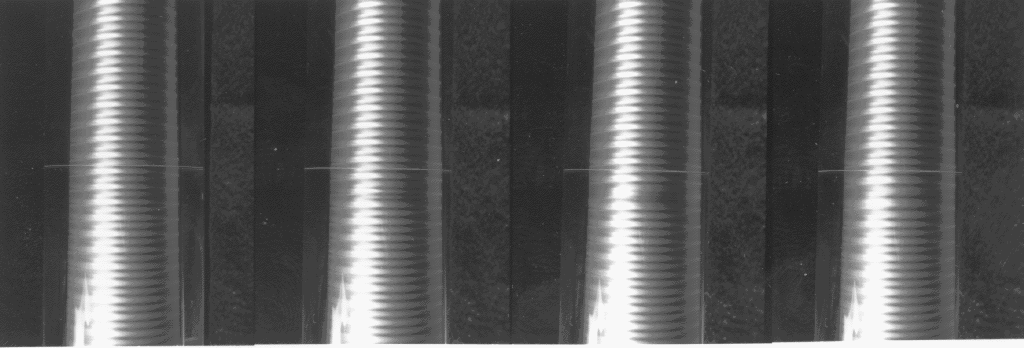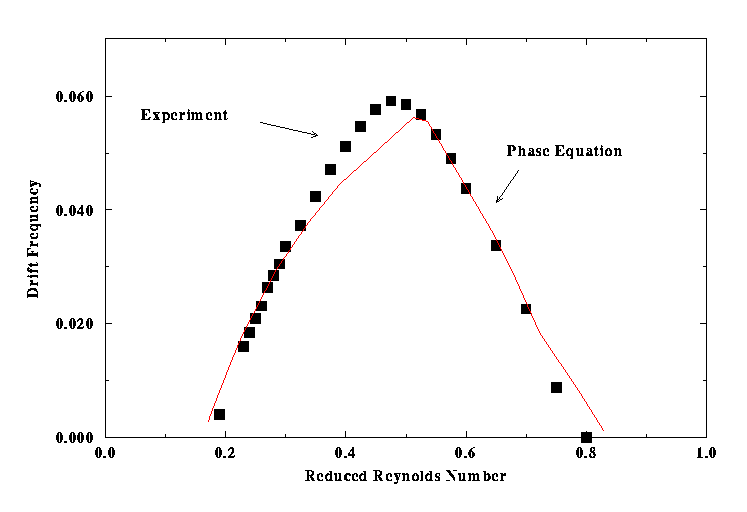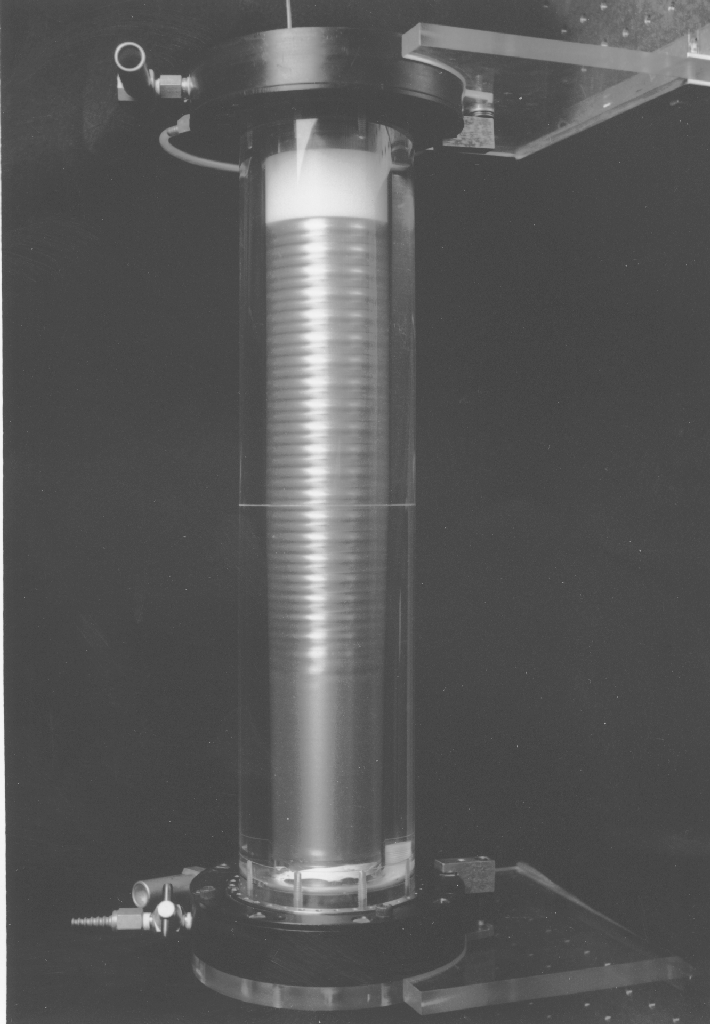Theory: H. Riecke and H.-G. Paap,
Phys. Rev. A 33 (1986) 547; Phys. Rev. Lett. 59 (1987) 2570.
The stability limit is given by the
Eckhaus instability, which is a long-wave sideband instability. It
usually does not saturate and eventually leads to the destruction or
creation of a vortex pair. Such a process is shown in the sequence
of figures below.

Photos:
courtesy L. Ning and G. Ahlers, UCSB.
As
time progresses from left to right a vortex pair located just below
the thin white marking line is destroyed leaving behind a vortex pair
with larger wavelength. In the usual set-up, eventually the pattern
will equilibrate to a spatially constant wavelength.
The long-wave Eckhaus instability can also be captured by the phase diffusion equation
It can be derived arbitrarily far from threshold, i.e. even in the strongly nonlinear
regime. Here X = ex and T = e2t are slow spatial
and temporal variables with e << 1 characterizing the slowness
of the spatial and temporal variations. The phase F gives the local
wavenumber q(X,T) via
Axisymmetric Taylor vortex flow is described by the streamfunction y
for the vortical motion and the azimuthal velocity v . The diffusion coefficient
is given by
where A and B denote large expressions in terms of the spatially
periodic solutions y(F(X,T)/e) and v(F(X,T)/e) ,
|
A = < V1+r¶fv+V2+( |
1
r
|
q2¶f2+4 |
~
D
|
)¶fy > |
|
|
|
|
|
< V1+ |
é
ê
ë
|
- |
r
2
|
(1+2q¶q)¶fv+ |
æ
ç
è
|
|
h2-m
h(1+h)
|
- |
1-h
2r
|
ö
÷
ø
|
¶qy+¶yy¶qv-¶qy¶yv |
ö
÷
ø
|
> + |
| |
|
|
< V2+ |
é
ê
ë
|
|
æ
ç
è
|
|
q2
r
|
¶f2+4 |
~
D
|
ö
÷
ø
|
(1+2q¶q)¶fy-2 |
q2
r
|
¶f3y |
| |
|
|
|
ì
í
î
|
|
Th2(1+h)
2(h2-m)
|
|
v
r
|
+ |
Th3
2(h2-m)(1-h)
|
|
æ
ç
è
|
|
1-m
r2
|
- |
h2-m
h2
|
ö
÷
ø
|
ü
ý
þ
|
¶qv |
| |
|
| ¶yy |
ì
í
î
|
|
æ
ç
è
|
|
4
r
|
|
~
D
|
+ |
3q2
r2
|
¶f2 |
ö
÷
ø
|
¶qy |
ü
ý
þ
|
-q¶fy¶y |
1
r2
|
¶f- |
æ
ç
è
|
2q2¶fy¶y |
1
r2
|
¶f+q2¶f2¶y |
1
r2
|
y+4¶y |
1
r
|
|
~
D
|
y |
ö
÷
ø
|
¶qy ] > . |
|
|
and < ... > denoting the average over one period of the solution (for
details see H.-G. Paap and H. Riecke, Phys. Fluids 3 (1991) 1519).
When the gap between the two cylinders is wider (radius ratio=1/2)
the stability limits become more asymmetrical due to
a resonance between modes with wavenumber q and wavenubmer 2q. It results in a significant
and relatively sudden deviation of the fully nonlinear theory (solid line) from the
weakly nonlinear theory (dashed line) for low wavenumbers.

In a system like that depicted
in the top figure, in which one or both of the cylinders are tapered
providing a spatial ramp in the Taylor number the band of stable
wavenumbers collapses to a single wavenumber. Experimental and
theoretical results are given in the figure below (theory: solid
line, experiment: plusses). The wave numbers selected by ramps
employing different ratios of the tapering angles of the two
cylinders are shown as dashed lines.

Theory: H. Riecke and H.-G. Paap,
Phys. Rev. A 33 (1986) 547; Phys. Rev. Lett. 59 (1987) 2570.
Experiment:
M.A. Dominguez-Lerma, D.S. Cannell and G. Ahlers, Phys. Rev. A 34
(1986) 4956.
When a wave number is selected which
is Eckhaus-unstable (cf. the two right-most selection curves in the
above figure) persistent dynamics arises in which vortex pairs are
annihilated in the bulk and resupplied via the ramp. Thus the
phaseslip process shown above occurs repeatedly and a drift of the
pattern is generated. The plot below shows the measured and
theoretically determined frequency of this dynamics.

Theory: H.-G. Paap and H. Riecke,
Phys. Fluids 3 (1991) 1519.
Experiment: L.
Ning, G. Ahlers and D.S. Cannell, Phys. Rev. Lett. 64 (1990) 1235.





